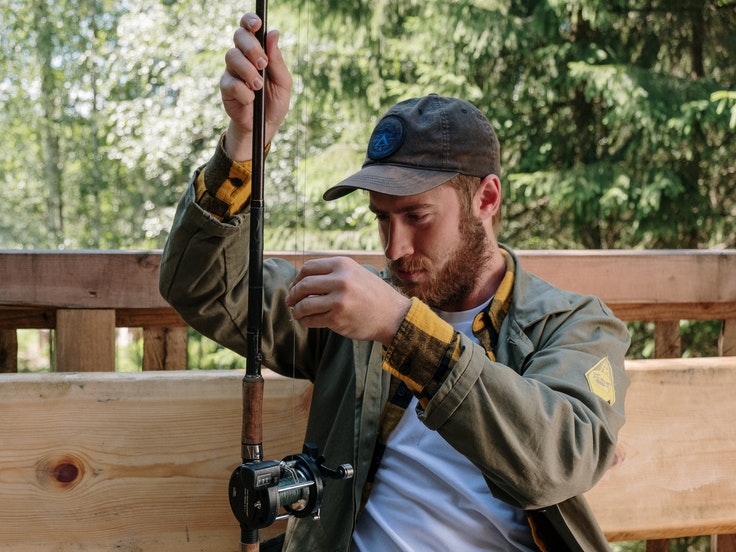
The filling stage of a casting reel is very important. If it's done properly, you'll be able to store your line in the best possible way for successful casting. This will save you a lot of trouble once you're out on the water, including the notorious wigs.
To do this properly, you first need to get the right equipment. You'll need to choose your fishing line, nylon or braid, and opt for a diameter to suit your technique and model. Depending on your choice, you'll need a container filled with water, backing, a fishing rod and, why not, a little help.
You'll need to follow the step-by-step process of setting up the various components. You'll need to keep an eye on a number of important aspects, including the strength of the knot, which will be very important when you land a big pike.
You'll need to be patient. As far as possible, try to rotate your crank fairly evenly so as not to create any slack in the spool of your casting reel. On all models, Abu Garcia, Daiwa or others, this could cause problems when the drag is applied. The ratio or fast retrieve speed will inevitably take less time.
Once you've done that, you'll understand the system for all the other casting reels in our collection. Whether you're a sea angler, a trout fisher or a surf caster, you'll be sure of your set-up and at peace on the water.
Preparations
First of all, to be able to carry out this operation, it's essential to have both the reel in question and the line you want to install. You'll need to make an important choice at this stage.
You'll need to opt for either braid, nylon or fluorocarbon. You'll choose the former for its strength and its ability to transmit information to the hand. The latter is perfect for dampening vibrations, while fluorocarbon offers invisibility and increased sensitivity. The diameter will depend directly on your selection and whether it matches the reel's capacity.
Once you've decided on this aspect, you'll need to prepare a few things to make filling easier. You'll need water, a fishing rod, glue, low-quality or used line and a container.
You'll need enough space to handle your rod without running the risk of banging it into objects that could damage it. Don't hesitate to go outside if you can. Or, if you have a 2-piece rod, leave the tip off to save space. The more comfortable you are, the more you'll be able to concentrate on your lining operation.
Then you'll be ready, or almost ready. If your reel capacity is greater, you'll probably need to buy a second reel or have one lent to you so that you can adjust the level as much as possible. This will be a great help when casting once you're out fishing.
Set-up stages
Let's take the example of choosing braid. As braid is the most commonly used line by anglers these days, this will be an opportunity to help as many people as possible, as it can be used with a wide range of fish species.
To begin with, you'll need to unwind 3 to 4 m of braid from your new spool. You then pass it little by little along the rings of your rod, passing through the head ring to reach your reel. You will have filled your reel with a little backing beforehand.
This will have two main advantages
- Avoiding your braid slipping around your reel
- Ensuring that the braid reaches the maximum capacity of your reel.
You will then need to connect these two lines. We recommend you use a classic splice knot, as for your fluorocarbon leaders. It is essential to test the strength of the knot. It could save you some nice fish in a fight.
Once you've done this, plunge your braid spool into a container filled with water. This will wet the whole thing. This will make it easier to arrange your braid correctly and tightly. This will ensure that you don't get a lot of wigs on the first few casts.
You'll need to turn your crank regularly to fill your spool little by little. Depending on the reel and its ratio, the operation may take more or less time. As far as possible, you should try to keep the movement regular to ensure a uniform pattern.
It's time to stop when you get within 1/2mm of the lip of the reel. At last you're ready to fish with your combo.
A few tips to make the operation simple
If this is your first reel of this type, we suggest you start with fairly large lines. It will be simple to set up, suitable for both trout and pike fishing and will allow you to perfect your first casts. To assist you, we have developed a series of guides to help you choose your casting reel for big bait or any other technique.
Another point is that you need to fill your reel to the brim. The amount of braid you have will directly affect your retrieve speed. The fewer braids you have, the lower your speed will be. This can weight to changes in your fishing habits. The drag will also be less precise at these times. This can weight to fish being lost during the fight. It is therefore essential to be precise in this respect.
Finally, spool rotation can sometimes incorporate a little slack in the retrieve. This lack of tension can easily cause casts to turn into wigs. To avoid this, don't hesitate to cast a lure that pulls a lot from time to time, in order to tighten up a good part of it and avoid trouble on future casts.
Our other articles on casting reels :
